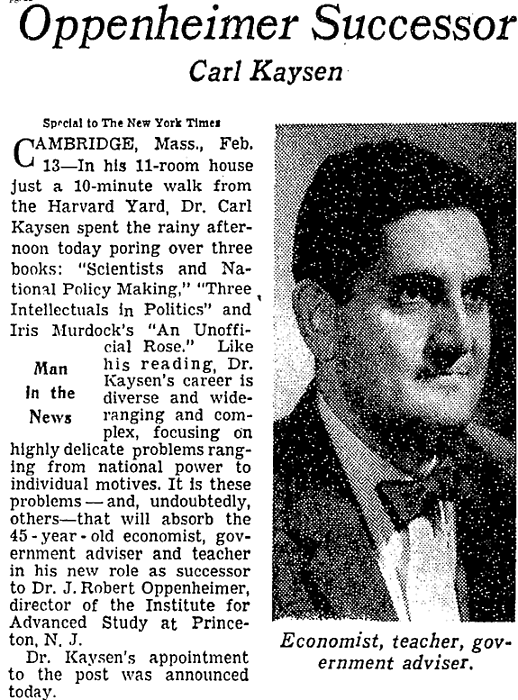Freeman Dyson: Reflections on a Friendship with Carl Kaysen

Carl Kaysen, the Institute’s Director from 1966–76, died on February 8, 2010, at the age of eighty-nine. A political economist with a distinguished career in public service, Kaysen used his tenure at the Institute to broaden its academic scope, including creating the School of Social Science, which was formally established in 1973.
Freeman Dyson, Professor Emeritus in the School of Natural Sciences, has worked with six Directors since joining the Faculty of the Institute in 1953. He gave the following remarks at a memorial for Kaysen held at the American Academy of Arts and Sciences on May 22.
Carl was my close friend, and I was fighting by his side for the ten years from 1966 to 1976 that he was Director of the Institute for Advanced Study. I was sorry that I saw little of him after he left Princeton. We stayed friends, and I would sometimes get delightful hand-written letters from him. One of the last came three years ago. Here is an extract from it, in memory of our friendship. It shows Carl at eighty-six remaining as bright and good-humored as he was in Princeton thirty years earlier. He is writing from MIT on November 9, 2006.
Dear Freeman,
I read with great pleasure your account in Technology Review of life at Bomber Command during World War Two. It brought back memories of my semi-parallel activities at the time, as well as the occasion when I was driving you from Princeton to Cape Cod and we got so involved in exchanging World War Two reminiscences that I forgot to look at the gas gauge. The result: the spectacle of the Director of the Institute for Advanced Study and one of its professors pushing a Volkswagen along the Jersey Turnpike to the fortunately nearby service station.
Carl was always like that. He knew how to make the best of a bad situation. A bad situation became bearable when he treated it with a big dose of irony.
As you all know, Carl was in a bad situation at Princeton when he established the School of Social Science at the Institute for Advanced Study. Some Institute mathematicians had never forgiven the Institute Trustees for appointing Robert Oppenheimer as Director twenty years earlier. They decided to take their revenge on Carl. They organized a noisy public campaign against Carl, rather like the campaign of the tea-party Republicans against Obama. I was asked by the Institute Trustees to write a statement of my views, and here is the gist of what I wrote. “Carl Kaysen is as good a Director as we are likely to get and better than we deserve. He has made great efforts under difficult conditions to establish a first-rate program in social science. . . . During the nearly twenty years that I have been a member of the Faculty, a number of my colleagues have been slandering, harassing, and intriguing against the Director. It seems to make no difference who the Director is or what he is trying to do. ... I cannot take seriously the pretensions of the Faculty to collective wisdom in the governance of the Institute. For twenty years our Faculty meetings have been distinguished by an astonishingly low level of discourse. ... The Director is doing his job well, and will continue to do so provided that the Board continues to support him. Our internal problems are not worth more than twenty minutes of a busy man’s time.”
Carl stood firm and ended his ten-year tenure as Director with the Institute peaceful and the School of Social Science running smoothly. During the time of troubles, when insults and threats were flying freely, Carl kept cool. He called the affair the Froschmäusekrieg, the war of frogs and mice. He got this word from Helen Dukas, the secretary of Albert Einstein, who got it from Einstein. Einstein had used it to describe a famous squabble that happened in 1928 between two groups of European mathematicians. The original Froschmäusekrieg was a fight about the editorship of the German mathematics journal Mathematische Annalen. Einstein wrote in one letter: “This ink war would for me be one of the most funny and successful farces performed by people who take themselves deadly seriously,” and in another: “With best wishes for an ample continuation of this noble and important battle, I remain yours truly, A. Einstein.” Carl was like Einstein, viewing the strange antics of mathematicians with amused detachment. One year after he left Princeton, Carl wrote me a letter summing up his experience as Director. “Despite the quarrels and pains, it was worth the ten years. I really believe we left the place better than we found it; and I suppose to ask for more, or to expect gratitude, is to seek to transcend the human condition. And that would be impious.”
I am supposed to talk only for five minutes, and so I cannot tell you how much I learned from Carl about the big world outside Princeton in which he played an active part. To give you the flavor of Carl as he performed on the national scene in Washington, I end with a quote from his testimony before the Foreign Relations Committee of the United States Senate on November 24, 1970. In reply to a question by Senator Case of New Jersey, he says: “I think if the government of country X is content to have its people buy Coca-Cola, it would be most unwise for the Government of the United States to say, ‘That isn’t good for you; you really ought to spend that money on milk, or you really ought to spend that money on roads, or something of the sort.’ I just don’t think that would be wise.” Carl had a wonderful gift for demolishing lofty pretensions with simple facts. He lived in the real world. He did not expect our gratitude, but he earned it.